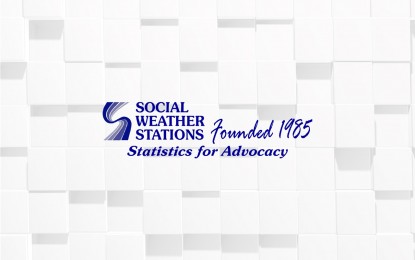
MANILA -- The number of Filipino families who experienced "involuntary" hunger from July to September fell to 9.1 percent or an estimated 2.3 million, according to the latest survey conducted by pollster Social Weather Stations (SWS).
The September 27-30 poll found that hunger incidence in the past three months was down by 0.8 percentage point from the 10 percent or about 2.5 million Filipino families registered in June.
“This is a recovery from the 10 percent (estimated 2.5 million) in June 2019, following an increase from the 9.5 percent (estimated 2.3 million families) in March,” the SWS noted.
Of the 9.1 percent or estimated 2.3 million Filipino families, about 7.4 percent or about 1.8 million experienced “moderate” hunger, while the remaining 1.7 percent or about 426,000 families had to endure “severe” hunger.
Compared to figures last June, “moderate” hunger fell by 1.3 percentage points from 8.7 percent or an estimated 2.1 million families, while “severe” hunger rose by 0.4 percentage point from 1.3 percent or an estimated 320,000 families.
The pollster noted that the latest hunger rate is the “lowest in over 15 years.”
“The last time total hunger was lower than 9.1 percent was when it reached 7.4 percent in March 2004, with 4.6 percent moderate hunger and 2.8 percent severe hunger,” the SWS noted.
The survey showed a drop in hunger incidence among self-rated poor (14 percent or about 1.4 million families from 16.2 percent or estimated 1.8 million families) and self-rated food poor families (15.8 percent or about 1.1 million families from 17.3 percent or 1.5 million families).
Hunger incidence also declined in Metro Manila (8.3 percent or estimated 276,000 families from 15.7 percent or about 520,000 families) and in Balance Luzon (8.1 percent or estimated 893,000 families from 9.3 percent or estimated 1 million families).
The SWS noted that a “steady” hunger rate in the Visayas (8.7 percent or about 407,000 families) and an increase of 2.9 percentage points in Mindanao (11.9 percent or estimated 673,000 families from nine percent or estimated 508,000 families).
Some 1,800 adult Filipinos were interviewed by the SWS, using sampling error margins of ±2.3 percentage points for national percentages, ±4 percentage points each for Balance Luzon and Mindanao, and ±6 percentage points each for Metro Manila and the Visayas.
Anti-hunger initiatives ‘working’
Presidential Communications Operations Office Secretary Martin Andanar said the poll results only proved that the efforts of President Rodrigo Duterte’s administration to eradicate hunger in the country are “working.”
“We see the drop in our national hunger rate as hard evidence that the government programs to address hunger and poverty are working,” Andanar said in a statement.
“For some, the drop to 9.1 percent from the previous quarter's 10 percent may seem nominal, that is just about 200,000 less families from June's 2.5 million families, but to us, this means that the steps concerned agencies are taking are in the right direction,” he added.
Andanar assured the public that the government would continue implementing programs aimed at addressing both poverty and hunger.
He noted that Republic Act (RA) 10941 or the Free Education Act; RA 11223 or the Universal Health Care Act; and RA 11310 or the Pantawid Pamilyang Pilipino Program are among the laws to help “reduce poverty and poverty-related problems in the country.”
Andanar added that the government is also working to create more jobs by implementing programs, such as the Government Internship Program and JobStart, as well as by focusing on sectors that generate more job opportunities.
He further said that the current administration is pursuing programs that would address the issue of food supply and food costs.
“The administration is prioritizing the agriculture and aquaculture sector through development programs,” he said.
“It is also fortifying the implementation of the Comprehensive Agrarian Reform Program, and its infrastructure thrust will ensure that adequate and efficient farm-to-market linkages are made, along with dams for water supply needed by farms,” Andanar added.
On October 11, Duterte also approved the Expanded Partnership against Hunger and Poverty (EPAPH), a program involving more state departments that will work closely to eradicate hunger in the country by 2030.
The EPAPH seeks to add more members to its original agency members, which include the Department of Agriculture, the Department Agrarian Reform, and the Department of Social Welfare and Development.
The other agencies that are part of the EPAPH are the departments of education, health, local government, and science; the National Nutrition Council; the National Youth Commission and Land Bank of the Philippines.
Among the priority programs under the EPAPH are the provisions for the institutional feeding programs; credit support for community-based organizations; and capacity-building and productivity improvement for community-based organizations.
The EPAPH will also push for nutrition education; establishment of agricultural facilities and technologies, food hubs, and other infrastructure facilities; mobilization of funding, technical and research assistance from local development partners; and advocacy and education. (PNA)
